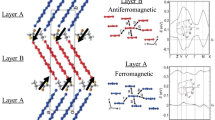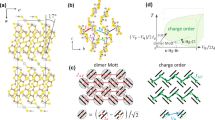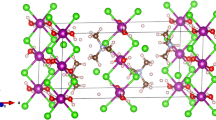Abstract
Heat capacity measurements of quasi-two-dimensional Mott insulating compounds consisting of BEDT-TTF (bisethylendithiotetrathiafulubalene) donor molecules and counter anions were performed by the thermal relaxation calorimetry technique for single crystal samples. No distinct thermal anomalies at the predicted antiferromagnetic transition temperatures in κ-(BEDT-TTF)2Cu[N(CN)2]Cl (T N = 27 K) and β′-(BEDT-TTF)2ICl2 (T N = 22 K) were observed. These results demonstrate that the Mott insulating state of the organic salts which are dominated by the strong two-dimensional intra-layer antiferromagnetic interactions between neighboring S = 1/2 spins shows somewhat different features from the simple quasi-two-dimensional Heisenberg model with S = 1/2. The strong quantum fluctuations produced by the electron correlations suppress the long-range character of the spin correlations, which seems to be an important aspect of this kind of Mott insulating materials.




Similar content being viewed by others
References
Urayama H, Yamochi H, Saito G, Nozawa K, Sugano T, Kinoshita M, Sato S, Oshima K, Kawamoto A, Tanaka J. A new ambient pressure organic superconductor based on BEDT-TTF with Tc higher than 10 K (Tc = 10.4 K) Chem Lett. 1988;55–8.
Kini AM, Geiser U, Wang HH, Carison KD, Williams JM, Kwok WK, et al. A new ambient-pressure organic superconductor κ-(ET)2Cu[N(CN)2]Br, with the highest transition temperature yet observed (inductive onset T c = 11.6 K, resistive onset = 12.5 K). Inorg Chem. 1990;29:2555–7.
Miyagawa K, Kawamoto A, Nakazawa Y, Kanoda K. Antiferromagnetic Ordering and Spin Structure in the Organic Conductor, κ (BEDT-TTF)2Cu[N(CN)2]Cl. Phys Rev Lett. 1995;75:1174.
Yoneyama N, Miyazaki A, Enoki T, Saito G. Magnetic properties of TTF-type charge transfer salts in the Mott insulator regime. Bull Chem Soc Jpn. 1999;72:639–51.
Miyagawa K, Kawamoto A, Kanoda K. Charge ordering in a quasi-two dimensional organic conductor. Phys Rev B. 2000;62:7679.
Shimizu Y, Miyagawa K, Kanoda K, Maesato M, Saito G. Spin liquid state in an organic Mott insulator with a triangular lattice. Phys Rev Lett. 2003;91:107001.
Yamashita S, Nakazawa Y, Oguni M, Oshima Y, Nojiri H, Shimizu Y, et al. Thermodynamic properties of a spin-1/2 spin-liquid state in a κ-type organic salt. Nat Phys. 2008;4:459.
Kanoda K. Recent progress in NMR studies on organic conductors. Hyperfine Interact. 1997;104:235–49.
Nishi T, Kimura S, Takahashi T, Ito T, Im HJ, Kwon YS, et al. The origin of the phase separation in partially deuterated κ-(ET)2Cu[N(CN)2]Br Studied by infrared magneto-optical imaging spectroscopy. Solid State Commun. 2005;134:189–93.
Kagawa F, Itou T, Miyagawa K, Kanoda K. Magnetic-field-induced Mott transition in a quasi-two-dimensional organic conductor. Phys Rev Lett. 2004;93:127001.
Ito H, Ishiguro T, Kubota M, Saito G. Metal-nonmetal transition and superconductivity localization in the two-dimensional conductor κ-(BEDT-TTF)2Cu[N(CN)2]Cl. J Phys Soc Jpn. 1996;65:2987–93.
Williams JM, Kini AM, Wang HH, Carlson KD, Geiser U, Montgomery LK, et al. From semiconductor-semiconductor transition (42 K) to the highest-T c organic superconductor, κ-(ET)2Cu[N(CN)2]Cl (T c = 12.5 K). Inorg Chem. 1990;29:3272–4.
Nakazawa Y, Kanoda K. Electronic structure of insulating salts of the κ-(BEDT-TTF)2X family studied by low-temperature specific-heat measurements. Phys Rev B. 1996;53:8875.
Müller J, Lang M, Steglich F, Schlueter JA, Kini AM, Sasaki T. Evidence for structural and electronic instabilities at intermediate temperatures in κ-(BEDT-TTF)2X for X = Cu[N(CN)2]Cl, Cu[N(CN)2]Br and Cu(NCS)2: implications for the phase diagram of these quasi-two-dimensional organic superconducors. Phys Rev B. 2002;65:144521.
Taniguchi H, Miyashita M, Uchiyama K, Satoh K, Mori N, Okamoto H, et al. Superconductibity at 14.2 K in layered organics under extreme pressure. J Phys Soc Jpn. 2003;72:468–71.
Matsumoto T, Miyazaki Y, Albrecht AS, Landee CP, Turnbull MM, Sorai M. Heat capacities of the S = 1/2 two-dimensional Heisenberg antiferromagnet Bis(2-amino-5-chloropyridinium) tetrabromocuprate(II) [(5CAP)2CuBr4] and its diamagnetic analogue [(5CAP)2ZnBr4]. J Phys Chem B. 2000;104:9993–10000.
Sengupta P, Sandvik AW, Singh RRP. Specific heat of quasi-two-dimensional antiferromagnetic Heisenberg models with varying interplanar coupling. Phys Rev B. 2003;68:094423.
Kobayashi H, Kato R, Kobayashi A, Saito G, Tokumoto M, Anzai H, Ishiguro T. The crystal structure of β′-(BEDT-TTF)2ICl2. A modification of the organic superconductor, β-(BEDT-TTF)2I3. Chem Lett. 1986;89–92.
Nakazawa Y, Taniguchi H, Kawamoto A, Miyagawa K, Hiraki K, Kanoda K. Thermodynamic studies of electron correlation effects on organic salts based on BEDT-TTF and DCNQI molecules. J Phys Chem Solids. 2001;62:385–8.
Sun K, Cho JH, Chou FC, Lee WC, Miller LL. Johnston DC. Johnston DC. Heat capacity of single-crystal La2CuO4 and polycrystalline La2−xSrxCuO4 (0 ≤ x ≤ 0.20) from 110 to 600 K. Phys Rev B. 1991;43:239.
Okuma K, Yamashita S, Nakazawa Y, Oguni M, Miyagawa K, Kanoda K. Spin ordering and enhancement of electronic heat capacity in an organic system of (DI-DCNQI)2(Ag1−xCux). J Phys Condens Matter. 2009;21:015602.
Souza JA, Neumeier JJ, Jardim RF. Effect of disorder on the thermodynamic phase transition in La0.70Ca0.30MnO3. Phys Rev B. 2007;75:012412.
Author information
Authors and Affiliations
Corresponding author
Rights and permissions
About this article
Cite this article
Yamashita, S., Nakazawa, Y. Heat capacities of antiferromagnetic dimer-Mott insulators in organic charge-transfer complexes. J Therm Anal Calorim 99, 153–157 (2010). https://doi.org/10.1007/s10973-009-0566-6
Published:
Issue Date:
DOI: https://doi.org/10.1007/s10973-009-0566-6




